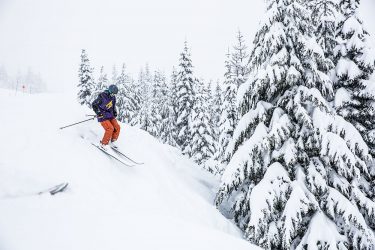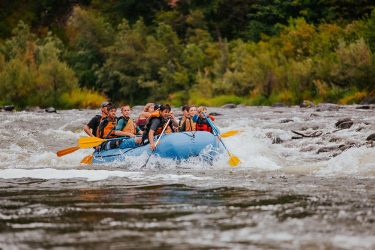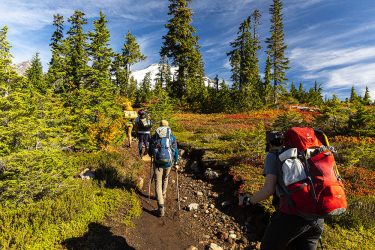As the seasons change in Washington state from winter to spring, you can almost hear the collective cheers at the promise of warmer weather and sunnier days. For some, though, this time of year also marks the dreaded end of winter fun, as snow starts melting on the Pacific Northwest’s tallest peaks. But how will climate change affect outdoor recreation, not only during these transitional periods but throughout the year? And what can we expect in the coming years and decades?
According to Climate Impacts Group Director Amy Snover, “we should expect warmer winters with less snow in higher elevations, earlier springs, with the snowpack melting sooner than what we have typically experienced in the past, and hotter and drier summers.”
Climate change’s effects on winter sports

Warmer winters with less snow in higher elevations is unwelcome news for skiers, snowboarders and snowshoers. When will the big changes come?
The snow is “not going to all go away instantly,” said Snover. “It’s not even going to all go away this century. But one of the challenges we have in the Northwest is that our mountains aren’t that tall, so when you think about where the snowline is and how high the mountains are, there’s not a lot of extra space up there. The warmer it gets, the higher the snowline also gets.” All of which means less snow to play in.
When Climate Impacts Group scientists looked at how much the snow season in the Cascades might shrink in the future, they found that, for the 4,000-5,000 foot elevation range, we can expect the length of the snow season to decrease by nearly half by the end of the century. Compared to the historically typical 142 days of snow on the ground that the Cascades experienced from 1950-1999, we can expect the snow season to last only 87 days on average in the 2080s. That being said, natural climate variability will still bring us individual years with a lot more snow, as well as years with a lot less snow as the average decreases.
How fast the Northwest loses snow depends on how quickly society chooses to reduce greenhouse gas emissions. Under a moderate greenhouse gas emissions scenario, Washington state would lose 46% of its end-of-winter snowpack by the 2040s compared to the 20th century average, and lose 70% by the 2080s. That means the lower and more southerly places would lose their snow, leaving snow only in the colder, higher places up north. If greenhouse gas emissions are significantly reduced, snow losses would be less, especially later in the century.
Changing rivers and lakes affect swimmers, rafters and fishers

Less snow, however, doesn’t equal less precipitation. The expectation is that the total amount of precipitation will increase in winter, spring and fall, with more falling as rain and less as snow, meaning higher river flow in the fall and winter, and lower river flow in the late spring and summer. Many rafters and kayakers in Washington visit rivers that depend on mountain snow melt, and can expect peak streamflows from snowmelt to be lower overall. The melt will also likely happen earlier in the spring. For all the whitewater fans out there, the ideal time to raft might be a month earlier in some rivers.
Those same rivers, come late spring and summer, will have lower flows and warmer water than what we have seen historically. This will affect some recreational lakes in the area, where many Washingtonians have already seen dried out “dead zones” in the surrounding banks.
Hiking, backpacking, camping and mountaineering

Washington has some of the most scenic peaks in the country, and hiking has always been one of the most popular outdoor activities for both residents and tourists. The start of COVID-19 saw a spike in people hitting the trailheads as a way to escape the city and recharge in nature. Snover sees the changing climate affecting this group of people in two main ways.
The first major change is the loss of mountain snowpack. The consequences may include earlier trail and campground access as the snow melts earlier, and later access in the fall before snow accumulates. Public lands managers may have more staffing challenges, due to the need to staff campgrounds, provide back-country rangers, and fill other roles over a longer recreational season.
With decreased snowpack, winter precipitation will bring more rain, causing erosion and higher river flows which will wash out trails, bridges and roads. Heavy rain events are also expected to be more intense in the future — under a high greenhouse gas emissions scenario, about 22% more rain will fall during the heaviest rain storms in the 2080s compared to the 1980s. This not only affects the trail itself, but flooding and landslides may make road access to the trails and campgrounds more difficult. Both Olympic and North Cascades National Parks identified such access impediments as a primary concern in their recent climate change vulnerability assessments.
The second issue is something that the entirety of the western United States has already experienced: wildfires. The western US has already seen more area burn in recent years, partially due to climate change, and projections show bigger and more frequent fires moving forward. This could lead to more trailhead closures due to ongoing fires or high fire risk, and poor air quality from smoke may keep more hikers indoors.
After a wildfire is out, all the dead and downed trees require maintenance and management. Trails may be closed entirely as the US Forest Service and others try to reduce the risk of falling trees injuring hikers, and normally moderate hiking trails may become much more strenuous as hikers have to hurdle fallen tree trunks. Streams and rivers downstream of fires are also affected, generally leading to bigger floods in winter, lower flows in summer, and higher water temperatures.
However bleak this all sounds, there are still actions we can take now to protect the future of outdoor recreation. Decreasing and working to eliminate greenhouse gas emissions will reduce the amount of climate change that actually occurs. And taking climate impact science into account when managing and restoring public lands for recreation is essential for minimizing the negative impacts of the changes that we cannot avoid.
“The future isn’t written, meaning we don’t know exactly what will happen,” said Snover. “We have already set some climate change impacts in motion, but how bad it is on the ground here in the Northwest depends on how quickly we act to reverse it.”
View this post on Instagram

